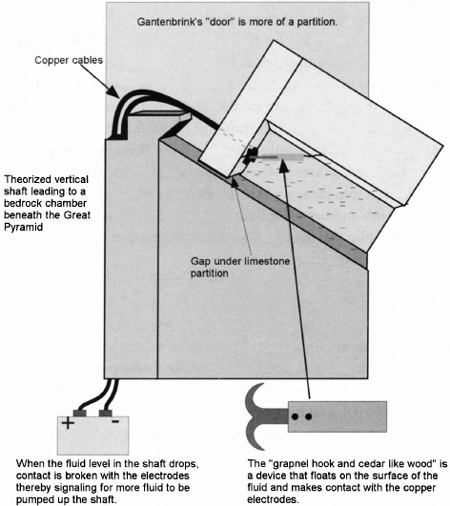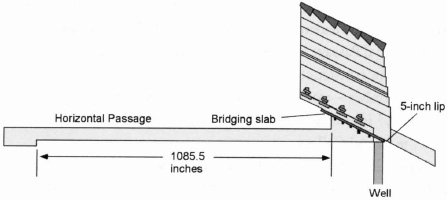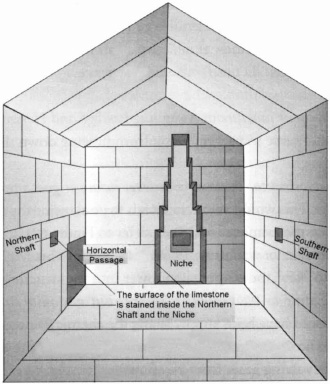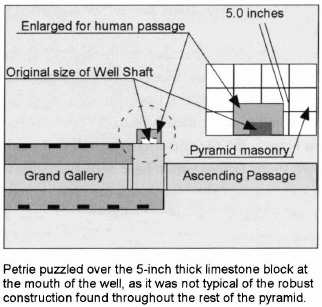The Giza Power Plant (30 page)

F
IGURE
63.
Gantenbrink's "Door"

F
IGURE
64.
Fluid Switch
Where the robot ended its trek up the Southern Shaft, the walls, ceiling, and floor of the shaft were smooth, as they would have been when first fitted together. On the other hand, the texture of the walls and floor of the shaft at the lower levelâas photographed by Gantenbrinkâwas deeply eroded, with horizontal striations, and there also appeared to be leaching of
salts on the surface of the ceiling and the walls. Both of these conditions could have been caused by a chemical fluid.
The recent investigation by Tom Danley in the Great Pyramid took him into the Queen's Chamber, where he tested the Southern Shaft using an acoustic device. By calculating the time it took for the sound wave to travel the distance of the shaft, bounce off the "door," and return to the sensing device, he was able to determine the length of the shaft. But Danley detected something else. The device heard a secondary echo. This echo was produced by the sound squeezing through the small gap at the bottom of the door and traveling through into the space beyond, the space where Gantenbrink had offered to go with another robot but was denied the opportunity. Danley's instrument told him that the sound wave traveled another thirty feet before bouncing back to the source.
Notwithstanding the fact that there is no tangible evidence of what lies behind Gantenbrink's "door," what has been discovered fits extremely well into the power plant theory. It also allows us to extrapolate, for the present, what lies hidden from view and predict what further explorations may uncover when the block Gantenbrink discovered is finally penetrated. A hint of what might be there came in 1992 when French engineer and professor Jean Leherou Kerisel, and his team, conducted ground-penetrating radar and microgravimetry tests in the short horizontal passage that leads from the Descending Passage to the Subterranean Pit. He detected a structure under the floor of the passageway which he analyzed as possibly being a corridor oriented SSE-NNW and with a ceiling at the same depth that the Descending Passage would have reached had it been continued.
Hancock and Bauval reported on Kerisel's findings:
Nor was this all. A second very clear anomaly, a "mass defect" as Kerisel calls it, "was detected on the western side of the passageway six metres before the chamber entrance. According to our calculations, this anomaly corresponds to a vertical shaft at least five metres deep with a section of about 1.40 Ãâ 1.40 metres very close to the western wall of the passageway."
In short, what Kerisel believes he has identified off the Subterranean Chamber's entrance corridor is something that looks very much
like a completely separate passageway system, terminating in a vertical shaft. His instruments may have misled him, or, as he himself admits, he may merely have picked up the traces of "a large volume of limestone dissolved by the action of underground waterâin other words a deep cave". Alternatively, however, if the "mass defect" turns out to be a man-made feature, as he strongly suspects, then "it may lead to very interesting
developments.
"
5
Kerisel's findings indicate that the supply shafts leading to the Queen's Chamber may have been supplied with chemicals by means of a vertical shaft that connected to an underground chamber. It should be noted that Kerisel detected the vertical anomaly on the west side of the passageway. The shafts leading to the Queen's Chamber are oriented to the west of the passageway. In light of my proposed use for these shafts, and of Kerisel's discovery, it would not be out of order for us to postulate that when Gantenbrink's "door" is penetrated, or when the clandestine diggers above the King's Chamber reach their destination, a vertical shaft leading to a bedrock chamber will be found. I also would not be surprised if more copper, in the form of cables or wires that had been attached to the "copper fittings," are found beyond Gantenbrink's "door" (refer to Figure 64).
We can now understand how chemicals were introduced to the Queen's Chamber and caused a reaction that filled all the cavities within the Great Pyramid with hydrogen. But during the fueling process, moisture and impurities would had to have been removed from the gas. How was this done? The means existed to remove water vapor and impurities from hydrogen gas. The gas had already given up some moisture and impurities in the Queen's Chamber, leaving salt encrustation on the walls and ceiling. The long Horizontal Passage that connects the Queen's Chamber with the Grand Gallery, being constructed out of limestoneâthe same material as the Queen's Chamberâwould work in the same manner and remove residual moisture and impurities from the gas as it filled that passage and flowed toward the Grand Gallery.
At the juncture where the Horizontal Passage meets the Ascending Passage is a five-inch lip. There may have been a slab resting against this lip and bridged between the Ascending Passage and the floor of the Grand Gallery,
where a similar lip is found. Slots in the sidewall indicate that there may have been supporting members for this slab, which would have had holes drilled into it to allow the gas to rise into the Grand Gallery. At this juncture, and to the west, a hole in the wall leads to what is known as the Well Shaft. Perhaps the Well Shaft is the only feature of the Great Pyramid that has been accurately named. Spent chemical solution from the Queen's Chamber would have flowed along the Horizontal Passage and down the Well Shaft into either the Grotto or, if the shaft at that time connected to the lower Descending Passage, the Subterranean Pit below. The lip and a bridging slab would have prevented the fluid from flowing down the Ascending Passage (see Figure 65).
One of the questions that always arises regarding my theory about the Great Pyramid, and one that should be on our minds at present, is what happened to the original equipment that sustained the operation of the power plant? While it is a generally accepted belief that some objects have been removed from the Great Pyramid, it is impossible to define exactly what was removed, when it was removed, and who removed it. Tradition teaches us that it was a king's mummy and vast treasures that made grave robbing such a lucrative business in Egypt. However, considering the proposition in these pages, other treasures removed from the Great Pyramid were far more valuable than the funerary trappings that accompanied an Egyptian king. Why these objects were removed and by whom I cannot say, but the features we examined from the King's and Queen's chambers, and from the Grand Gallery and its juncture with the Horizontal Passage, lend themselves to speculation that objects were there and provide us a clue to what these objects
were. As I have just argued, I believe these objects were parts of a great machine, the Giza power plant. The evidence in the Queen's Chamber (see Figure 66) alone points to a finely tuned operation that used a chemical reaction to create hydrogen. Let us review this evidence.

F
IGURE
65.
Bridging Slab
- five-inch lip at juncture of Ascending Passage and Horizontal Passage.
This could serve to prevent waste from flowing down the Ascending Passage. - drop in Horizontal Passage floor level before it goes into the Queen's Chamber.
This would allow chemicals to pool inside the chamber and "wick" up the evaporation tower (refer to Figure 62). - corbeled niche in wall of the Queen's Chamber.
This may have been a means to "key" the evaporation tower into the structure. - shafts leading to the Queen's Chamber but not quite connected to it.
These could have been supply shafts for chemicals needed in the reaction. The shafts would allow chemicals to enter the chamber and prevent evolving gases from escaping. - stone ball, grapnel hook, and cedarlike wood.
The wood and hook assembly could have served as a floating contact to signal the need for more chemical. The stone ball may have been used to prevent erosion of the "left" as the channel filled with fluid. - flakes of gypsum exuding from joints in shafts.
This substance probably resulted from the chemical reacting with limestone (suggesting the use of sulfuric acid). - buildup of salt crystals on the walls and ceiling of the Queen's Chamber, Horizontal Passage, and lower level of Grand Gallery.
This buildup was likely the result of gaseous vapor passing over the limestone, reacting with the calcium in the limestone, and giving up water and impurities. This was a by-product from the drying of the gas. - Well Shaft bored from the juncture of the Grand Gallery and the Horizontal Passage down to the Grotto.
This was probably either a waste removal shaft or an overflow shaft. - large granite block at the bottom of the Well Shaft at the level of the Grotto.
Most likely this was put into place to catch the chemical overflow, thereby preventing erosion of the limestone.

FIGURE 66.
Niche Inside the Queen's Chamber
It is unfortunate that such havoc was wreaked inside the Great Pyramid as early explorers bored and tore away barriers. The Descending Passage and the Well Shaft were recipients for much of the refuse from those expeditions. More recently another area of the pyramid has allegedly been used as a waste disposal site for limestone residue from tunneling. There are speculations that there is a clandestine effort to reach Gantenbrink's "door" by tunneling from one of the chambers above the King's Chamber. Tom Danley reported that the limestone chippings from this effort were being placed in burlap bags and taken to another chamber above in an effort to keep the project a secret. If this is true, we have reason to worry, for if the tunnelers ultimately reach their destination, who knows what damage they ill inflict in this area? In a manner similar to explorations of earlier times, valuable features may be destroyedâby the pickaxes and chisels of these modern treasure seekersâbecause they are unrecognizable within the context of a tomb.
Chapter Twelve
MELTDOWN

M
uch of the evidence that supports the theory that the Great Pyramid
was a power plant is the result of a malfunction of the generation process. The hydrogen in the power center (King's Chamber) for some inexplicable reason exploded in an awesome ball of fire, and the power plant suffered a "meltdown." The King's Chamber was affected in a disastrous way. Its walls were pushed out nearly an inch and the ceiling beams cracked.
The operators of the power plant, noting that there was an interruption of the energy coming from the pyramid, had to enter the pyramid to make repairs. They spread plaster over cracks in the ceiling beams, apparently making no pretense to neatness, for the plaster was daubed on freely, almost as though they had used their fingers. The question we must ask is, Would the spreading of plaster on these giant monoliths improve the structural stability of the ceiling? Or was it for another reason that the Egyptians took the trouble to seal the cracks? It would seem that if the granite beams in the ceiling of the King's Chamber were suddenly to give way, a smear of plaster would do little to prevent them from smashing into the chamber. But if the Great Pyramid were a machineâa power plantâthen the sealing of these cracks may make sense.
If the fuel that fed the operation of the power plant was hydrogen gas, it is conceivable that it was necessary for the operators to contain the gas as completely as possibleâfor an excessive leak might have decreased the efficiency of the power plant. Therefore, when the guardians entered the King's Chamber and found severe cracks in the ceiling, it may have made sense to them to seal the cracks while they were checking out the rest of the damage and making whatever repairs they thought necessary. Whether the sealing of the cracks was essential was probably a chance the guardians could not
afford to take; after leaving the pyramid and resuming the operating cycle, they would not have wanted to reenter the pyramid in order to repair a simple leak.
The structural displacement of the King's Chamber is not the only clue that the heart of the Great Pyramid experienced a powerful release of energy. Another supporting clue which may have been the result of the same events that caused the disturbance in the King's Chamber, was found in one of the so-called "relieving" chambers above. As we recall, when Howard-Vyse's men blasted through tons of limestone and granite and discovered the four chambers above Davison's Chamber, the first part they went into had a strange effect on them. They crawled out of the air space covered from head to toe with a fine, thin black powder. The floor of the chamber was covered with it. Analysis of the powder showed it to be exuviae, the cast-off shells and skins of insects.
This discovery has remained a mystery. Where did the exuviae come from? None of the other chambers contained it. The space directly above the King's Chamber contained nothing but bat dung. There were no living insects found in the Great Pyramid, and it is doubtful that a group of insects would single out this one chamber and collectively, or repeatedly over a period of time, shed their skins.
My theory may account for this black powder. The anomalous creation of energy within the King's Chamber, which forced the granite walls away from their original position and cracked the granite beams above, also may have been responsible for the exuviae in the chamber above Davison's Chamber. Insect shells are comprised mainly of calcium carbonate, and if we look for a source for calcium carbonate in the area, we find it in the core limestone masonry itself. The core blocks of the pyramid are comprised mainly of nummulitic limestone made up of fossilized seashells and foraminifers. If there was an explosion inside the King's Chamber of sufficient magnitude to push aside hundreds of tons of granite, it is possible that with that explosion, and in the presence of elevated temperatures, the surface layers of limestone in close proximity would be affected too. The scenario may have gone like this: The initial explosion jolted the entire granite complex, pushing the walls out and lifting the ceiling beams up off their support blocks. As the ceiling beams came crashing back down, they
cracked along the south end and, at the same time, some of the limestone core masonry in the spaces above the King's Chamber may have been impacted and crushed by their fall, causing limestone dust to fill the air. As the crushed limestone hung in the air it quite literally could have cooked in the elevated temperatures of the hydrogen explosion and the fire that followed. The black calcium carbonate dust would have settled finally onto the tops of the granite beams.
The guardians, alarmed at the sudden malfunction within the power plant, then gained access to the inner chambers of the pyramid by climbing down the Descending Passage and up the Well Shaft to the level of the Grand Gallery. They cut through to what is now known as Davison's Chamber, where they inspected the next layer of granite. While in this chamber they could have cleaned away the limestone dust (exuviae) from the top of the beams, which is why the exuviae was not discovered until an opening was made by Howard-Vyse into the chamber above.
Another feature inside the granite complex known as the King's Chamber that is left unexplained by orthodox theories is the so-called sarcophagus. We have already discussed a purpose for this box, but we really have not addressed why the pyramid builders selected a type of granite for the box that was a different color than the granite with which they constructed the chamber. The box is chocolate colored, and there is no granite like that to be found in Egypt! It has been speculated that it came from the Americas or the mythical Atlantis. If this is true, why would the pyramid builders find it necessary to import a single, large block of chocolate-colored granite from across the world to construct a sarcophagus when they could have used red granite, of which there was plenty available in their own country?
Well, perhaps they did not.
Again my theory of the Giza power plant provides a reasonable answer. Perhaps the coffer was originally red, quarried at the same time, in the same place, as the rest of the granite used to construct the King's Chamber. If an object like this box was subjected to excessive energy levels, what would be the effects? Depending on other elements that were present at the time of the malfunction of the power plant, it is conceivable that certain changes would be recorded in any object fortunate enough to survive the accident. The comparatively thin sides and base of the coffer would naturally be more
susceptible to excessive energy levels than would be the huge granite blocks comprising the walls and ceiling of the King's Chamber. It is possible, therefore, that the granite box, because of its thinner construction, did not have the ability to conduct the heat to which it was subjected and so it simply overcooked, causing the color change. Architect Jim Hagan, who is an expert in the application of stonework in construction, explained to me that the interior chambers of the Great Pyramid have the appearance of being subjected to extreme temperatures; and he claimed that the broken corner on the granite box shows signs of being melted, rather than simply being chipped away.
The awesome force unleashed inside the King's Chamberâof such magnitude that it melted graniteâalso would have consumed other susceptible materials. If the resonators in the Grand Gallery were made of combustible material, such as wood, they most likely would have been destroyed at the same time. Evidence to support this speculation comes from reports that the limestone walls in the Grand Gallery were subjected to heat and, as a result, the limestone blocks calcinated or burned. The disaster that struck the King's Chamber, therefore, may have been responsible for destroying the resonators.
After shuddering to a stillness that they had not experienced for years, or even decades, the inner chambers of the Giza power plant lay in smoking ruins. Not knowing to what extent their machine was damaged, the operators would choose a route that would leave the interior chambers intact, in case they were able to make repairs and put the power plant back in service. The most obvious route would have been the Well Shaft. As we now turn our attention to the Well Shaft, a feature around which much debate has swirled, its existence begins to make sense in the context of my theory. Many Egyptologists credit the guardians of the Great Pyramid with carving an access tunnelâthe Well Shaftâto the inside of the Great Pyramid to inspect damage from an "earthquake." This is a reasonable assumption because only those with knowledge of the internal passageways of the Great Pyramid would know where to dig their tunnel. However, considering the meandering and tortuous path of the Well Shaft, it was either a remarkable stroke of luck that their bore came out where it did, or they were in possession of some fairly advanced instruments for detecting the location of the
Grand Gallery, or a connection between the Well Shaft and Grand Gallery already existed.
Petrie presented evidence that showed the Well Shaft, from the Grand Gallery to the level of the Grotto, to be part of the original structure of the Great Pyramid. Therefore, instead of having to carve out the entire length, the guardians only had to carve their hole to the level of the Grotto. When the pyramid was being built, the portion of the well that was bored through the bedrock down to the Grotto would have been accessible to the workers. Once the work was accomplished, however, the constructed portion from the bedrock up to the level of the Grand Gallery would only need to be large enough to allow passage of the chemical overflow from the Queen's Chamber. And this is exactly what we find when we examine the Well Shaft dimensions. Petrie described the constructed portion of the Well Shaft as being rather shoddy work. Furthermore, he could not understand why a block that was used in its construction was positioned a mere 5.3 inches from the Grand Gallery wall. He wrote:
On examining the shaft, it is found to be irregularly tortuous through the masonry, and without any arrangement of the blocks to suit it; while in more than one place a corner of a block may be seen left in their regular curved side of the shaft, all the rest of the block having disappeared in cutting the shaft. This is a conclusive point, since it would never have been so built at first. A similar feature is at the mouth of the passage, in the gallery. Here the sides of the mouth are very well cut, quite as good work as the dressing of the gallery walls; but on the s. side there is a vertical joint in the gallery side, only 5.3 inches from the mouth. Now, great care is always taken in the Pyramid to put large stones at a corner, and it is quite inconceivable that a Pyramid builder would put a mere slip 5.3 thick beside the opening to a passage. It evidently shows that the passage mouth was cut out after the building was finished in that part. It is clear, then, that the whole of this shaft is an additional feature
to the first plan.
1
Based on all the evidence, the only explanation for the constructed portion of the Well Shaft near the Grand Gallery is that it was enlarged to
allow the guardians access to the Grand Gallery after the explosion in the King's Chamber, and this excavation resulted in the thin block of limestone on the south side (see Figure 67).

F
IGURE
67.
Well Mouth
Evidence that the Well Shaft was part of the original design also was proposed by Celeste Maragioglio and Vito Rinaldi, who noted that the the walls upward from the Grotto to the Grand Gallery were lined with regular blocks of limestone. They argued that because a part of this lining was through the bedrock, it must have been a part of the original design and
construction.
2
The existence of a large block of granite wedged in the mouth of the Grotto provides other evidence that the Well Shaft was part of the original design. The granite, being more impervious to erosion than the limestone, may have served to catch the chemical flow from the Queen's Chamber and direct it into the deep hole to the side of the Well Shaft. If the Well Shaft did not exist until the guardians made their damage assessment inspection, then they must have taken the block of granite from somewhere inside the Great Pyramid's main passages or chambers and dropped it down the Well Shaft. It makes more sense that the granite was a part of the original design, already in place, and that the guardians, or any other theorized interlopers, only had to push it aside when they reached the level of the Grotto (see Figure 68).